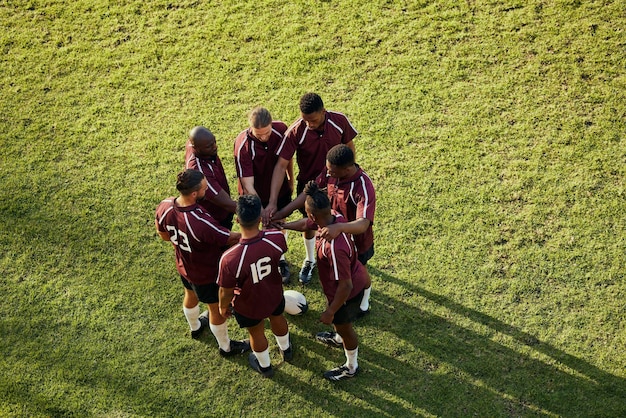Concussion Protocols in Youth Football: Protecting Young Athletes

Concussion protocols in youth football are designed to protect young athletes by establishing guidelines for preventing, recognizing, and managing concussions, with recent updates aiming to enhance player safety.
The safety of young athletes is paramount, especially when it comes to the risk of concussions in sports like football. Concussion protocols in youth football have been implemented to mitigate these risks, but questions remain about their effectiveness in protecting young athletes. What are these protocols, and are they truly making a difference?
Understanding Concussion Protocols in Youth Football
Concussion protocols in youth football are a set of guidelines and procedures designed to prevent, recognize, and manage concussions among young athletes. These protocols aim to ensure that players who sustain a concussion receive proper medical care and do not return to play until they are fully recovered.
These protocols are crucial because young athletes are more vulnerable to the effects of concussions than adults. Their brains are still developing, and a concussion can have more severe and long-lasting consequences. Recognizing the signs and symptoms of a concussion is the first step in protecting these athletes.
Key Components of Concussion Protocols
Concussion protocols typically include several key components, each aimed at different aspects of concussion management. These components work together to create a comprehensive approach to player safety.
- Education: Educating coaches, parents, and athletes about the signs and symptoms of concussions.
- Prevention: Implementing strategies to reduce the risk of concussions, such as proper tackling techniques.
- Recognition: Ensuring that coaches and medical staff can recognize the signs and symptoms of a concussion.
- Removal: Immediately removing any player suspected of having a concussion from play.
- Return-to-Play: Establishing a gradual return-to-play protocol that ensures the athlete is fully recovered before returning to the field.

These components are essential for creating a culture of safety in youth football. By educating everyone involved, implementing preventive measures, and ensuring proper recognition and management of concussions, we can better protect young athletes from the potential long-term effects of brain injuries.
In conclusion, concussion protocols in youth football are a vital framework for safeguarding young athletes. They encompass education, prevention, recognition, removal, and a structured return-to-play process, ensuring comprehensive concussion management.
The Importance of Recognizing Concussion Symptoms
Recognizing the symptoms of a concussion is a critical part of protecting young athletes. Many concussion symptoms can be subtle and easily overlooked, making education and awareness essential for coaches, parents, and players.
Early recognition of concussion symptoms can lead to prompt medical attention, reducing the risk of more severe complications. It also ensures that the athlete is removed from play, preventing further injury.
Common Concussion Symptoms
Concussion symptoms can vary from person to person, but some of the most common signs include:
- Headache
- Dizziness
- Confusion
- Memory problems
- Nausea or vomiting
- Sensitivity to light or noise
- Balance problems
- Blurred vision
It’s important to note that not all symptoms may be present immediately after the injury. Some symptoms may develop hours or even days later. Therefore, close monitoring and vigilance are crucial.
Recognizing and promptly addressing concussion symptoms is essential for preventing further harm. Timely medical attention and adherence to return-to-play protocols are key to ensuring a full recovery.
In summary, recognizing concussion symptoms promptly is vital for safeguarding young athletes. Common symptoms include headache, dizziness, confusion, and memory problems, among others. Vigilance and timely medical attention are crucial for optimal recovery.
New Guidelines for Concussion Management
New guidelines for concussion management in youth football are continually evolving as research advances and our understanding of concussions improves. These guidelines aim to incorporate the latest evidence-based practices to enhance player safety.
These updates often focus on more conservative approaches to return-to-play, stricter monitoring protocols, and the use of advanced diagnostic tools to assess the severity of concussions.
Key Updates in Concussion Guidelines
Some of the key updates in concussion guidelines include:
- Baseline Testing: Conducting baseline neurocognitive testing to provide a pre-injury benchmark.
- Symptom Monitoring: Implementing more rigorous symptom monitoring during the return-to-play process.
- Graduated Return-to-Play: Following a gradual, stepwise approach to returning to play, with each step requiring the absence of symptoms.
- Medical Clearance: Requiring medical clearance from a healthcare professional before an athlete can return to full participation.

These updated guidelines are designed to protect young athletes by ensuring that they receive comprehensive care and do not return to play until they are fully recovered. They are based on the latest scientific evidence and represent a commitment to player safety.
In conclusion, evolving concussion management guidelines reflect advancements in research and clinical practice. Key updates include baseline testing, rigorous symptom monitoring, a graduated return-to-play approach, and mandatory medical clearance to ensure athlete safety.
The Role of Coaches and Parents in Concussion Safety
Coaches and parents play a crucial role in concussion safety in youth football. They are often the first line of defense in recognizing and managing concussions, and their actions can significantly impact the health and well-being of young athletes.
Effective communication between coaches, parents, and medical professionals is essential for ensuring that concussions are properly managed and that athletes receive appropriate care.
Responsibilities of Coaches and Parents
Coaches and parents have several key responsibilities when it comes to concussion safety:
- Education: Staying informed about the signs and symptoms of concussions and the latest concussion management guidelines.
- Observation: Observing athletes for any signs of a concussion during practices and games.
- Reporting: Reporting any suspected concussions to medical professionals and team officials.
- Support: Supporting athletes through the recovery process and ensuring they follow medical advice.
By fulfilling these responsibilities, coaches and parents can help create a culture of safety in youth football and protect young athletes from the potential long-term effects of concussions.
To summarize, coaches and parents are pivotal in concussion safety, serving as the first responders in recognizing and managing concussions. Their responsibilities include staying informed, observing athletes, reporting suspicions, and providing support throughout the recovery process.
Challenges in Implementing Concussion Protocols
Despite the best efforts, there are often challenges in implementing concussion protocols in youth football. These challenges can stem from a variety of factors, including limited resources, lack of awareness, and cultural resistance.
Addressing these challenges requires a multi-faceted approach that involves education, advocacy, and policy changes. It also requires a commitment from all stakeholders to prioritize player safety.
Common Implementation Challenges
Some of the most common challenges in implementing concussion protocols include:
- Limited Resources: A lack of funding for equipment, training, and medical staff.
- Lack of Awareness: Insufficient knowledge among coaches, parents, and athletes about the signs and symptoms of concussions.
- Cultural Resistance: Reluctance to remove players from play due to pressure to win or a belief that concussions are not serious injuries.
- Enforcement Issues: Difficulties in enforcing concussion protocols consistently across all teams and leagues.
Overcoming these challenges requires a concerted effort from all stakeholders. It also requires a willingness to challenge traditional attitudes and prioritize the health and well-being of young athletes above all else.
In conclusion, implementing concussion protocols in youth football faces several challenges, including limited resources, lack of awareness, cultural resistance, and enforcement issues. Overcoming these challenges requires a multifaceted approach and a commitment to prioritizing player safety.
The Future of Concussion Prevention in Youth Football
The future of concussion prevention in youth football looks promising, with ongoing research and technological advancements paving the way for safer playing conditions and more effective concussion management strategies. These advancements aim to reduce the risk of concussions and improve outcomes for athletes who sustain these injuries.
Continued investment in concussion research and technology is essential for protecting young athletes and ensuring the long-term health of the sport.
Emerging Technologies and Strategies
Some of the emerging technologies and strategies for concussion prevention include:
- Advanced Headgear: Developing helmets with improved impact absorption and sensors that can detect potential concussions.
- Improved Training Techniques: Implementing training programs that focus on proper tackling techniques and reduce head-to-head contact.
- Biomechanical Analysis: Using biomechanical analysis to identify high-risk plays and develop strategies to reduce the risk of injury.
- Data Analytics: Utilizing data analytics to track concussion rates and identify trends that can inform prevention efforts.
These advancements hold great promise for reducing the risk of concussions in youth football and improving the safety of young athletes. They represent a commitment to innovation and a dedication to protecting the future of the sport.
To summarize, the future of concussion prevention in youth football is promising, driven by ongoing research and technological advancements. Emerging technologies and strategies include advanced headgear, improved training techniques, biomechanical analysis, and data analytics to enhance athlete safety.
| Key Point | Brief Description |
|---|---|
| 🧠 Concussion Protocols | Guidelines for preventing, recognizing, and managing concussions in youth football. |
| 🤕 Symptoms | Common symptoms include headache, dizziness, confusion, and memory problems. |
| 🌱 New Guidelines | Evolving updates focus on stricter monitoring, gradual return-to-play, and medical clearance. |
| 🛡️ Future Prevention | Emerging technologies like advanced headgear and data analytics aim to reduce concussion risk. |
Frequently Asked Questions
▼
Concussion protocols are guidelines designed to protect athletes by establishing steps for concussion prevention, recognition, and management. They ensure proper medical care and safe return to play.
▼
Youth athletes are more vulnerable to the effects of concussions because their brains are still developing. Protocols help prevent severe, long-lasting consequences from brain injuries.
▼
Common symptoms include headache, dizziness, confusion, memory issues, nausea, sensitivity to light and noise, balance problems, and blurred vision. These symptoms may not appear immediately.
▼
Coaches and parents are crucial for recognizing concussion symptoms, reporting suspected concussions, and supporting athletes during recovery, ensuring they follow medical advice diligently.
▼
Challenges include limited resources, lack of awareness, cultural resistance (such as pressure to win), and difficulties in consistently enforcing protocols across all teams.
Conclusion
In conclusion, concussion protocols in youth football are essential for protecting young athletes, but their effectiveness depends on consistent implementation, ongoing education, and a commitment from all stakeholders to prioritize player safety. While new guidelines and technologies offer promise for the future, addressing the challenges and ensuring that these protocols are followed diligently remains crucial for safeguarding the well-being of young players.





